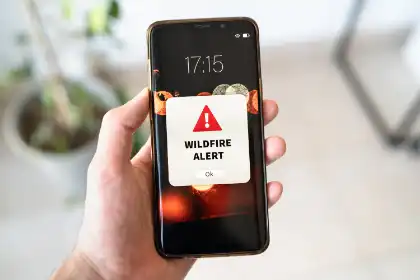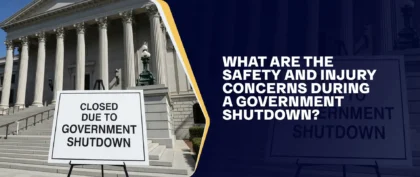Table of Contents
Envision this unsettling scene: smoke hangs thick in the air, and flames greedily eat away at your home’s perimeter. In the face of raging wildfires, seeking refuge in a swimming pool becomes a stark, desperate gamble. For some, this has tragically transformed from a mere thought experiment to a terrifying experience.
This dire situation compels us to ask: Can a plunge into cool water offer any real defense against the searing heat of a raging wildfire? Reports about the tragic August 2023 fires in Lahaina, Hawaii, show that some wildfire survivors escaped the flames by diving into a pool. So, is it a reliable safety solution during a wildfire?
Jumping into a body of water, such as a pool, lake, river, or ocean, to escape a wildfire is not a guaranteed or entirely safe survival strategy. While water might offer temporary protection from direct flames and intense heat, wildfires are highly unpredictable, and proximity to the fire can still pose serious risks.
The heat radiating from the fire can cause burns even if you’re in the water, especially if flames are nearby. Smoke inhalation remains a significant danger, and strong winds or flying embers can ignite areas around you. Worse still, encroaching flames can swiftly cut off escape routes along the shoreline or surrounding terrain, leaving you stranded.
It’s crucial to be prepared and have a plan in place. Early evacuation is the safest option whenever there’s a risk of wildfire. Don’t wait until the last minute.
Remember, wildfires are unpredictable and can change rapidly. Be informed, be prepared, and prioritize your safety.
Understanding Wildfire Behavior
Fueled by nature and worsened by human activity and climate change, wildfires can wreak havoc across vast swaths of land. They erupt quickly, leaving behind a trail of destruction, scarred landscapes, and devastated communities. These catastrophic events often result in shattered lives, with individuals facing wildfire injuries, loss, and displacement. Understanding how these fires behave is as crucial for Californians as earthquake drills are in school.
No two wildfires are the same. They’re unpredictable, constantly shifting and changing based on weather, terrain, and the amount of fuel available. The following are some critical factors to consider when trying to understand the nature of wildfires:
- The Dynamics of Wildfire Behavior — Wildfires tear through landscapes, fueled by dry brush and whipped by strong winds. The intense heat ignites nearby plants, creating a dangerous cycle where the fire keeps feeding itself. Under perfect conditions, wildfires can spread at 14 miles per hour. To survive a wildfire, you need to understand how they behave, even when considering the possibility of jumping into a pool.
- The Dangers of Wildfire Heat — Direct contact with flames isn’t the only way to sustain burn injuries during wildfires. The fire blasts out heat, turning the air into an oven. According to FEMA, intense heat radiating from a wildfire can ignite combustibles as far as 100 feet away. Imagine what it can do to your body and the water in the pool.
- The Hazards of Wildfire Smoke — Wildfire smoke, a mix of harmful gases and tiny particles, can cause severe lung damage, disorientation, suffocation, and respiratory distress. The National Fire Protection Association says that most fire deaths result from breathing in smoke, not burns. Jumping into a pool doesn’t guarantee safety; smoke can still reach you when you surface, leaving you vulnerable to its effects.
Pool Safety During Wildfires: Expert Analysis & Warnings
When wildfires break out, diving into oceans, lakes, or pools might seem appealing, but experts warn that such a strategy could spell disaster.
Experts emphasize the importance of prioritizing evacuation over seeking watery refuge during a fire, similar to how car accident lawyers stress the need for preparedness and informed, safe driving practices. Here’s why:
- Ash and Embers — Even if you avoid the flames, falling ash and embers pose a significant threat.
- Breathing Difficulties — As the fire advances, it becomes more difficult and dangerous to breathe.
The following experts have weighed in on the topic and expressed their opinions:
- Jack Minassian, a fire science associate professor at the University of Hawaii, stresses that water should be “a last resort.” He champions early evacuation and emphasizes the need for a well-thought-out escape plan with multiple routes.
- Carl Otsuka, a fire inspector with the Honolulu Fire Department, agrees: “You probably won’t get burned, but that’s not what’s going to kill you.” He continued, “It’s the smoke that’s going to kill you.” If roads become impassable, Otsuka advises a two-wheeled getaway. Relocate uphill and upwind to avoid the choking smoke.
- Crystal Kolden, a fire science professor at UC Merced, warns not to underestimate wildfire dynamics. While colossal fires rush like freight trains, smaller ones can leap ahead, sparking new infernos. “You can’t outrun these fires,” Kolden warns. Immersing yourself in water may trap you for hours, raising the risk of hypothermia or drowning.
Another major factor is that persistent and menacing smoke lingers long after the last flames flicker. “You literally can’t see anything, so you don’t know if it’s safe to get out yet,” Kolden said.
Alternative Refuge Options When Escaping Wildfires
Alternative safe havens may exist during a wildfire. In Australia, communities have pinpointed “nearby safer place[s]” as last-resort refuges for those unable to flee. Well-kept rugby or football fields become sanctuaries. “Those nice, green irrigated lawns, they don’t burn,” Kolden notes. Reaching these havens and staying low, where the air is cooler, improves survival odds.
When dealing with a wildfire, it’s crucial to find safe spots and move away from flammable materials that can produce deadly smoke. Open spaces like large fields, empty lots, or even the middle of a deserted parking lot can be a refuge during a wildfire, much like what happened in Paradise, California. During the devastating 2018 Camp Fire, 150 people sought shelter in a concrete parking lot, where they stayed safe for hours as the fire raged around them. This quick thinking saved many lives.
Ask yourself, “Where’s the nearest place that won’t catch fire?” Experts like Kolden suggest that this consideration could be essential for your safety.
While it may be tempting to jump into the water when flames are nearby, it’s important to be aware of the dangers lurking in such decisions. Early evacuation and careful planning are your best allies in the fight against a wildfire.
Swimming Pools And Wildfire Safety: Key Factors To Consider
When considering pools as lifesaving havens amid wildfires, several factors come into play, including the following:
- Pool Size — First, pool size and depth are crucial, as they must allow complete immersion. Shallow pools are no match for intense flames and choking smoke. Imagine what harm a shallow pool with boiling water could do to a person.
- Proximity to the Fire — The distance between the pool and the fire also affects safety; the closer you are to the fire, the greater the risk from radiant heat and falling debris. So, finding a water source at a safe distance from the encroaching blaze is essential.
- Physical Fitness — Personal abilities also play an essential role in survival. Your swimming skills, physical fitness, and mental readiness determine how well you can cope with this dangerous situation. The length of time you can stay underwater is also crucial. Your ability to hold your breath is vital when you are battling heat and fear.
It’s important to note that using a pool in these conditions carries its own risks, and swimming pool accidents can occur if people panic, slip, or misjudge water depth during a wildfire emergency. Seeking refuge in a pool during a wildfire should be a last-ditch option.
However, a pool can be a useful resource for fighting the fire itself by using pool water to douse flames or wet down surrounding vegetation. It can also provide a temporary source of water for soaking clothing or towels to protect against embers and heat.
During the Woolsey Fire in 2018, a Malibu homeowner successfully defended his property using a fire hose and water from his pool.
Potential Dangers Of Seeking Refuge In A Pool During A Wildfire
A pool might seem like a haven from wildfires, but it’s deceptively dangerous. Understanding these hidden risks is crucial for survival:
- Slip-and-Fall Injury — The smooth surfaces around a pool can be hazardous during a wildfire. A sudden fall may lead to broken bones, head injuries, or drowning. Slip-and-falls are a common risk in such emergencies, especially when panic, smoke, and debris reduce visibility and balance.
- Hypothermia — A pool can be dangerous during a wildfire, especially if the water is cold under the surface. Submerging in cold water can accelerate heat loss drastically, leading to hypothermia within minutes. This can cause chills, confusion, and life-threatening risks without swift intervention.
- Debris Hazards — During wildfires, high winds can carry a variety of debris into swimming pools, including smoke, ash, falling branches, and leaves.
- Wild Animals — Frightened and disoriented wildlife may seek refuge in the water or around the pool area during the fire. Never attempt to handle or approach wild animals yourself.
- Exhaustion — Treading water saps energy fast, heightening the risk of drowning, especially amid debris and smoky air.
- Smoke Inhalation — Surfacing to breathe exposes you to hazardous smoke, which can cause severe respiratory problems, including coughing and choking.
- Limited Mobility — As flames close in, escaping the pool becomes harder, leaving you trapped and exposed to heat and falling debris.
- Psychological Stress — The chaos of wildfires can lead to dread and panic, potentially clouding judgment and making it harder to stay calm and think clearly amid chaos.
Given these threats, retreating to a pool during a wildfire should be a desperate final measure. It’s crucial to evacuate early, following a well-prepared emergency plan. Your safety is paramount; plan wisely.
Tales Of Grit And Resilience During A Wildfire
When a wildfire strikes, survival often demands split-second decisions and unconventional thinking. Among these choices, jumping into a pool for refuge seems like a logical way to escape the searing heat and flames. How effective is this strategy? The stories below reveal the extraordinary grit and resilience of individuals who turned to water in their fight for survival.
The Lahaina Incident
Amidst Lahaina’s raging inferno, two courageous women jumped into a pool, seeking safety from the surrounding flames. They stayed in the water for three hours before firefighters could rescue them. Their gripping story highlights survival’s duality. Hope shines with brightness while risks remain ever-present in the water’s embrace.
The Pascoes’ Experience
In 2017, Santa Rosa, California, became a crucible for the Pascoe family as fire engulfed their surroundings. Jan and John sought refuge in a neighbor’s pool, enduring approximately three hours of intense heat from the nearby inferno. Their ordeal underscores the extreme physical and emotional strain of such life-threatening events, emphasizing the crucial need for composure and resourcefulness in desperate circumstances.
The Berriz Family Tragedy
The poignant story of Armando and Carmen Berriz illustrates the fragile nature of survival. As flames approached dangerously close, they sought refuge in a pool. However, in their desperate fight for safety, Carmen tragically succumbed to the relentless heat and smoke. This heartbreaking loss reveals a terrifying reality: water offers no guaranteed haven against fire. Survival remains a complex interplay of variables in which fate can strike with cruel unpredictability.
Guide To Staying Safe During A Wildfire
These wildfire safety tips are general recommendations and may not apply to every situation. Conditions can change quickly, and individual circumstances vary. Always follow instructions from local authorities and emergency officials during a wildfire.
Wildfires can spread rapidly and cause significant destruction, endangering lives and property. Climate change and land management have led to more frequent and intense fires. It’s essential to be ready and know what to do. This guide provides vital tips on how to stay safe during a wildfire, including what to do before, during, and after the blaze. Wildfire safety for you and your loved ones depends on a two-pronged approach: constant vigilance and prompt response.
Evacuate Early
To escape a raging inferno, evacuate as early as possible. A 2023 FEMA National Household Survey revealed that only 22% of over 7,000 respondents signed up for wildfire alerts, and less than half (49%) in high-risk areas believed they were vulnerable. This disconnect between perceived and actual risk may lead some to disregard evacuation warnings, putting themselves and their families in greater danger.
When evacuating, keep the following in mind:
- Protective Clothing — Wear long pants, long-sleeved shirts, heavy boots, a cap, a wet bandana to cover your face, goggles or glasses, and 100% cotton items to shield against flying embers.
- Emergency Kit — Prepare ahead of time with:
- Three-day supply of non-perishable food.
- Three gallons of water per person.
- A map with evacuation routes clearly marked.
- Prescriptions and medications.
- Change of clothes.
- Eyeglasses or contact lenses, if needed.
- Extra car keys.
- Credit cards and cash.
- First aid kit.
- Flashlight.
- Battery-powered radio with extra batteries.
- Sanitation supplies.
- Copies of vital papers like birth certificates and passports.
- Kids’ supplies:
- Diapers, wipes, and changing supplies.
- Baby formula or bottles.
- Favorite toys, comfort items, or blankets to soothe them.
- Small first aid kit for children.
- An extra set of clothes and shoes.
- Special needs items (inhalers, hearing aids, or medical equipment).
- Secure Your Home — Close all windows, vents, and doors to keep embers out. Turn off gas, electricity, and propane tanks to reduce fire risk.
- Stay Informed — Listen to emergency broadcasts, monitor local news, or check for mobile alerts on evacuation routes and safety updates.
- Plan for Pets — In a survey by the American Society for the Prevention of Cruelty to Animals (ASPCA), nearly 50% of pet owners left at least one pet behind during an evacuation. To prevent this, make sure to have an evacuation plan for your pets, including food, water, and carriers.
Actions If You Are Trapped Or Need To Shelter In Place
If you are trapped by a wildfire, staying calm and taking decisive action is critical to your safety. You might ask yourself, “What should I do if I can’t evacuate and a wildfire is approaching?” Whether inside a building or caught outdoors, knowing what to do can significantly increase your chances of survival. Here are some essential steps to take when escape is impossible, helping you minimize risk and protect yourself until help arrives.
- Call 911 — If you find yourself trapped in a car, a building, or on foot, call 911 and provide your location and situation.
- Stay Inside — If trapped in a building, turn on all lights to help firefighters spot you in heavy smoke. Close all windows, doors, vents, and fire screens, but leave the doors unlocked.
- Remove Curtains — Move all curtains away from windows and sliding glass doors to reduce fire fuel.
- Stay Low — Fill sinks and tubs with cold water, and avoid outer walls and windows.
- Vehicle Safety — If trapped in a car, park away from vegetation, close all windows and vents, use a wool blanket or jacket to cover yourself, and lie on the vehicle floor.
- On Foot — If trapped on foot, find an area without vegetation, like a ditch or ground depression, cover your body, lie face down on the ground, and wait for help.
Following these guidelines and preparing beforehand can significantly increase your chances of staying safe during a wildfire. Remember, early evacuation and having a well-thought-out plan are your best defenses against nature’s fury.
Post-Wildfire Safety: What To Do After The Flames Are Out
Once the wildfire has passed and the immediate danger subsides, uncertainty often follows about what to do next. Returning home is a top priority for evacuees, but it’s crucial to wait until authorities confirm it’s safe. Upon returning, be vigilant in assessing the situation and taking the necessary precautions to ensure your safety:
- Stay Alert — Hot spots can linger even after the fire has moved on. Conduct a thorough “fire watch,” checking for any signs of smoke, embers, or sparks, especially in areas like the roof and attic. Continue to monitor for several hours to catch any hidden dangers.
- Protect Yourself — Wear protective gear like thick boots and leather gloves when moving through areas where debris or burned materials are present. This will help guard against injuries from sharp objects or burning embers.
- Avoid Hazards — Stay clear of downed power lines and poles, and report them immediately to 911 or the utility company. Watch out for ash pits, which are smoldering holes where tree roots have burned. Avoid burned trees and remaining embers. Mark these hazards for safety.
- Secure Your Property — Wet down your roof and gutters to prevent lingering embers from sparking another fire. Stay connected to emergency alerts and local radio stations for updates. Use apps from organizations like the Federal Emergency Management Agency (FEMA) and the American Red Cross for real-time information.
- Handling Damage — During damage cleanup, wet down debris to reduce dust and wear a respirator mask to protect against airborne ash. Discard food contaminated by smoke or soot, ensure your water supply is safe, and take photos of the damage for insurance claims.
Evacuation is always the priority, but post-fire safety requires careful attention. Take proper measures when clearing debris and checking for hazards, as the risk can persist even after the flames are out.
Wildfire Liability And Compensation
Wildfires, often caused by human error or negligence, can result in devastating property damage and injuries. If there is evidence of negligence or liability for the fire, affected individuals may pursue claims against the responsible parties. Depending on the cause, this could include utility companies or government agencies.
One notable example is the Park Fire, which impacted communities in Butte and Tehama counties. Questions of park fire liability arose as investigators examined whether negligence or unsafe practices contributed to the fire’s spread.
One possible legal route is strict liability, which holds a party responsible for damages even without proof of fault. This concept often applies to cases where public entities like utility companies cause wildfires. Similarly, inverse condemnation allows property owners to seek compensation from government agencies or utilities for damage caused by their actions, even if no fault is involved.
In the aftermath of a wildfire, affected individuals may face significant losses, from damaged homes and business interruptions to fire-related injuries. Seeking legal recourse through claims may provide much-needed financial relief, helping victims rebuild their lives. The claims process for seeking damages can be complex, but with the right wildfire lawyer, victims can work to pursue compensation for their losses.
Frequently Asked Questions About Wildfire Survival
What Is The Best Way To Protect Myself From Wildfires?
The best way to protect yourself from wildfires is to take proactive steps to minimize risk and prepare for an emergency.
- Create a defensible space around your home by clearing flammable vegetation, using fire-resistant materials for landscaping and construction, and ensuring your home has ember-resistant vents.
- Stay informed about fire risks in your area by monitoring weather reports and fire alerts.
- Assemble a wildfire go bag with essential supplies, including food, water, medications, and important documents, and plan an evacuation route.
- Additionally, consider strengthening your home’s fire resilience by installing fire-resistant roofing and ensuring your property’s water supply is accessible for firefighting.
What Is The Safest Place To Be During A Wildfire?
During wildfires like the Clay Wildfire, the safest place is always far from the fire’s path. If you hear evacuation orders, don’t wait. Leave immediately and follow the designated escape routes. Driving through a wildfire should only be a last resort, as it is perilous. If you must drive, keep windows up, vents closed, and headlights on, and proceed cautiously through smoke while avoiding areas with active flames. If evacuation is not possible, seek a clear area free of vegetation or shelter in a building designed to withstand wildfires.
Who Should I Call About Wildfire Injuries?
When a wildfire rages and causes injuries, prioritize your health and call 911. After the emergency passes, consult a seasoned personal injury attorney. Their experience can help you understand your rights and options for pursuing compensation, covering medical expenses, property repairs, and disaster-related losses. Make informed decisions and find dedicated support to begin your recovery journey.
Pool Refuge In Wildfires: A Last Resort, Not A Guarantee
We stand in solidarity with families and communities affected by California’s devastating wildfires. Our law firm actively supports injured victims impacted by the Palisades Fire in Malibu and Topanga, the Eaton Canyon Fire in Altadena and Pasadena, and the Hughes Fire in the surrounding areas of Los Angeles.
Finding your way through the flames of a wildfire is no easy task. It requires a keen eye for lurking risks and the wisdom to make the right decisions. Although some people may view pools as a refuge, jumping into a pool can be dangerous, with dangers such as smoke inhalation and unrelenting heat lurking nearby. Remember that jumping into a pool should always be a last resort, which you should only do if you have assessed your surroundings and your strength.
Being prepared is your best defense against wildfires. Knowing what to do, practicing those skills, and having the right supplies can greatly improve your chances of survival.
The path after a wildfire may seem overwhelming, but you’re not alone. Arash Law is ready to guide you through the process of seeking financial recovery after this natural disaster. Think of us as your advocates, helping you pursue the compensation you may deserve under the law. We help clients seek settlements and awards as an established California personal injury law firm. Whether you’ve suffered injuries, property loss, or emotional trauma, our wildfire injury attorneys are here to help you pursue the compensation you may need to rebuild and recover.
If you’re wondering, “Do I need a personal injury lawyer?” call us at (888) 488-1391 to book your free, confidential initial consultation.














































